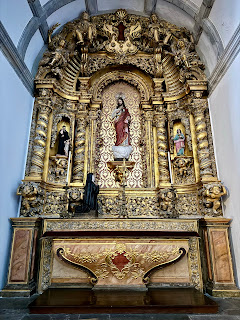Relying on the Weather App to plan our days is risky; in many places, the information is just not reliable. So far, the trip is going well, but today's forecast is changing by the hour. We believe it'll be a better day than yesterday, so today is our 'road trip' of Faial, and we start by driving west.
Our first stop is the Morro de Castelo Branco, a nature reserve with an unusual rock formation near the airport (we saw it from the plane); it's a fragment of some old volcanic event. Access is from a very bumpy farm road, and the thickening fog does not give us hope that we'll be able to see much. When we park and walk down the coastal path to the miradouro, we can just make out the top of the formation.
Though not branco today, the layering in the exposed geology is fascinating.
Next is the western-most point of Faial, the Vulcão dos Capelinhos. This is the site of a volcanic eruption from 1957 and includes a derelict farol (lighthouse), the fragments of several volcanic cones, and a field of volcanic dust – this is all a museum now.
When we arrive, the fog seems to be lifting. A walkway of concrete pavers across the shadowy sands connects the parking lot with the Farol da Ponta dos Capelinhos, which is crossed by a long, cobbled ramp down to the Centro do Interpretação do Vulcão dos Capelinhos. In fact, walking to the Farol, the walkway ends at the circular edge of the underground Centro's roof. To the north, an enormous mound of black power rises, and sweeps into the curvilinear structures suspended in the mist and spray.
The Centro is well-presented; it explains the volcanic system and the eruption that occurred, the cultural impact, and displays a fascinating collection of rocks and minerals. At the end of the cabinets full of the volcanic samples, there is a movie with a series of interviews that tells the story of the Azorean Refugee Act in which a significant percentage of the population of Capelo (pop 528 in 2021) relocated to the US (also the site of the eruption in 1672; we saw the memorial yesterday).
Ilha nova née du feu et de l'océan.[New island born of fire and the ocean.]
The tour ends in the ruined Farol. We explore the hollow base structure, everything still covered in crusty ash, and then ascend to the top. The scene is apocalyptic and compelling, with an intense wind and lots of atmospheric fog.
Pulling away, we stare at the nearly life-less beach, after more than sixty-five years – as if we are departing Mars.
Despite the fog, of maybe in defiance of it, we make the drive up Cabeço Gordo and the Miradouro da Caldeira. Our research tells is that there is a small parking area and a tunnel into the caldeira, fog or no fog, it's worth a shot.
However, the the fog is now impenetrable, and we see nothing. Walking through the tunnel, the stiff, misty wind coats us with damp and chases us back to the car.
We return to Horta (pop 14,331 in 2021) for lunch and enjoy a breezy walk on the Praia do Porto Pim, along with the small shore birds. There is little sunshine, but the hills sparkle with moss and the shore's edge gleams with foam.
Still carrying the scene at Capelinhos, this is the result of centuries of human effort and natural healing.
With the persistent grey day, we decide to try the Igreja Matriz again. We see the same sign we saw yesterday, but the door is open. We hear cheerful conversations from the church workers and enter – if this is 'community prayer' time, we won't disturb anything by looking around.
The interior of the Igreja Matriz do Santíssimo Salvador (seventeenth century) is clean and open, with deep, arched capelas laterais. There are lots of familiar figures: Nossa Senhora de Fátima (with shepherd children), Nossa Senhora de Lourdes ("Je suis l'Immaculee Conception"), Nossa Senhora da Boa Morte (with the Assumption scene), Sagrado Coroção de Jesus with Maria do Divino Coração, and Santa Cecília (with harp) with Santa Teresa de Lisieux (with roses and crucifix).
Closer to the altar, there are partial painéis de azulejos that seem to illustrate stories of financial and natural disasters, well-suited to these islands – of treasure being taking and children crying, and of people being lost at sea while other struggle to build a fire.
There are transepts with larger capelas: to the south is an elaborate capela for São Pedro (keys), and to the north is the Capela do Santíssimo Sacramento with its gated entrance.
Facing the nave are two capelas laterais on either side of the altar: to the south is a saint contemplating a skull (São Francisco?), and to the north is the Madonna and Child.
Inside the chancel, the painéis de azulejos show scenes of the lives of Santo Inácio de Loyola and São Francisco de Borja (eighteenth century).
The capela-mor is wonderfully theatrical and layered. The central figure is Christ as a small child. Beside the altar table is the Crucifixion. Above the altar vault, ascending and crowned, is the Virgin, with a porthole to provide the proper glow.
So, we have: youth, death, and the ever-after. As our Açores adventure winds down, we consider the people of Pico and Faial. The islands are staggeringly beautiful, but uncooperative to say the least. Whether dealing with fiery eruptions or crushing oceans, the people endure. Each museum, miradouro, or church adds a chapter to this history of faith and persistence.















































































































